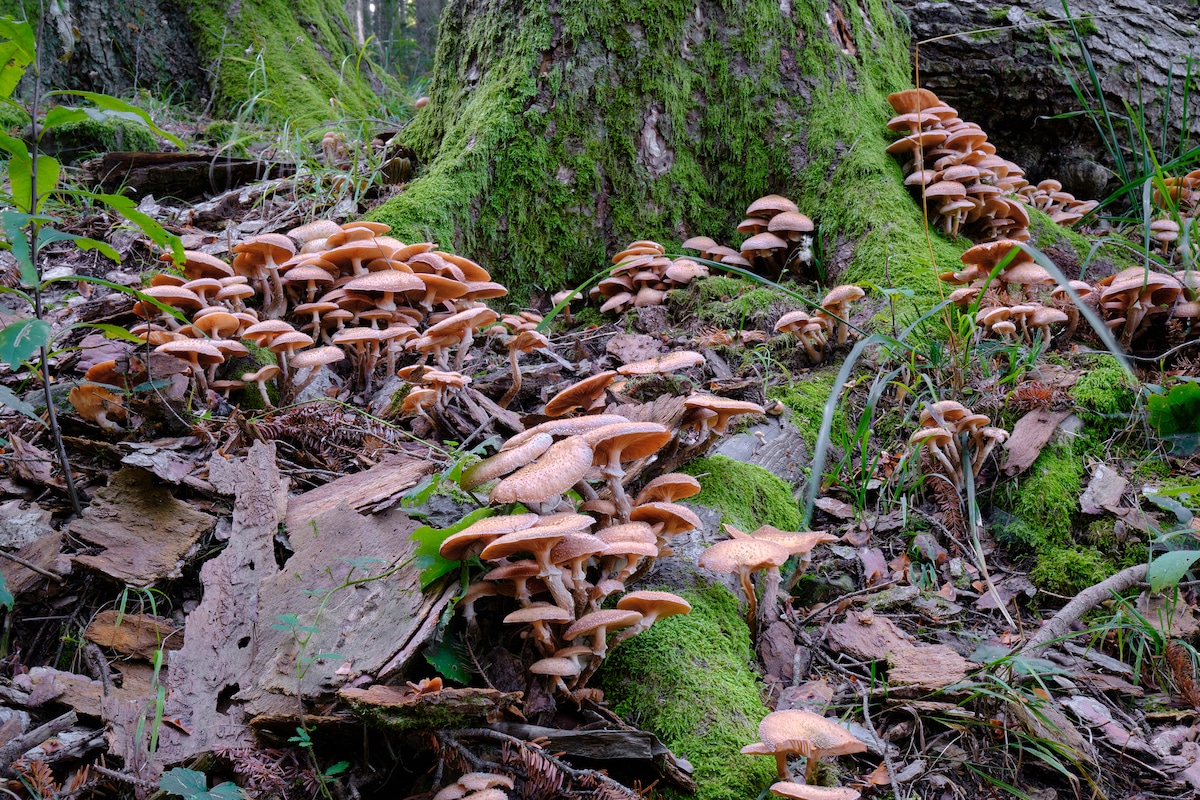Cultivating Mushrooms by Trees Could Feed Millions While Mitigating Climate Change, Research Finds

 Why you can trust us
Why you can trust us
Founded in 2005 as an Ohio-based environmental newspaper, EcoWatch is a digital platform dedicated to publishing quality, science-based content on environmental issues, causes, and solutions.
Edible mushrooms are a healthy and valuable source of protein, fiber, antioxidants and selenium, a mineral that protects against infections and cell damage.
A new study by scientists from the University of Stirling in Scotland has found that growing edible mushrooms adjacent to trees can not only provide food for millions, it can mitigate climate change impacts by capturing carbon, a press release from the University of Stirling said.
“We looked at the emerging field of mycoforestry, where fungi that grow in symbiosis with living trees are used to create a food crop from new tree plantings, and we found that production of fungi using this system can lead to a very significant sequestration of greenhouse gas,” Honorary Professor at the University of Stirling’s Faculty of Natural Sciences Paul Thomas, who was lead author of the study, said in the press release. “This is a huge benefit which means that by producing this food we can actively help mitigate climate change. When we compared this to other major food groups, this is the only one that would result in such benefits — all other major food categories lead to a greenhouse gas emission during production.”
The study, “Edible fungi crops through mycoforestry, potential for carbon negative food production and mitigation of food and forestry conflicts,” written by Thomas and Dean of the Faculty of Natural Sciences professor Alistair Jump, was published in the Proceedings of the National Academy of Sciences.
Trees and mushrooms have a symbiotic relationship in which trees provide a place for the mushrooms to grow and carbohydrates to nourish the fungi. In turn, mushrooms combine their root-like mycelium with trees’ roots, making it easier for the trees to absorb moisture and nutrients from the soil. Growing mushrooms as a mass food source therefore encourages the planting of trees while lessening the demand for deforestation to make room for agriculture.
“There are many ways in which different fungi grow. However, in this study we focus on a type defined as ectomycorrhizal and these require a living plant partner (often a tree) for their growth and survival. The fungus provides the tree with nutrition and water that it gathers from the soil environment and by return, the tree provides the fungus with sugars,” Thomas told EcoWatch in an email.
After analyzing published data, Thomas found that as many as 5.71 tons of carbon per acre could be sequestered each year by cultivating edible ectomycorrhizal fungi in forests. The annual yield would be enough to feed almost 19 million people. But there is still more research and planning to be done.
“To develop this on a large scale, we need to develop the process further to identify suitable species but also to make the cultivation process as cheap, quick and easy as possible. It’s only by making this process cost pence per tree that we’ll be able to get enough uptake for a sizeable impact. This is something we are keenly and actively focused on,” Thomas told EcoWatch.
Mushrooms contain all nine of the “essential amino acids” that make up a complete protein, making them nutritionally comparable to other non-meat proteins, like beans and rice, edamame, quinoa and buckwheat.
“Mushroom proteins do often have a complete essential amino acid profile. The protein content of one of the mushrooms we target in this study is around 17% of the dry weight,” Thomas said.
Globally, the biggest cause of deforestation is agriculture, which is predicted to increase. The conflicting land-use interests of agriculture and forest preservation have meant a net loss of about 11.6 million acres of forest area each year, data from 2010 to 2020 has indicated, according to the press release.
“We calculate that if this system was combined with current forest activities, the food production levels could be huge. If it had been used in forestry that has taken place during the last ten years, we could have produced enough food to feed 18.9 million people annually,” Thomas said in the press release. “For China alone, their forestry activity for the last ten years could have put in place a food production system capable of enough calorific output to feed 4.6 million people annually.”
Mushrooms can be grown alongside trees in varying climates all over the world.
“This approach should be possible in all forested regions. Those which show most production promise are probably temperate, boreal and sub-tropical,” Thomas told EcoWatch.
Biological carbon sequestration by trees absorbing carbon dioxide from the atmosphere and transporting it through root systems to be stored in the soil is one of the best ways to combat climate change.
“In general, replacing some level of meat in western diets, with fungi, would be very impactful and convey the strongest climate/environmental benefits possible. Of the food groups we compared… this system (listed as the fungi species L. delicious) is the only one that shows a negative figure [of greenhouse gas released in production,] which means it locks-up carbon,” Thomas said.
The practice of mycoforestry is still being developed.
“Truffle cultivation is a form of mycoforestry and this has been in place since the 1970s and currently produces over 95% of all the truffles in France (truffle research/cultivation is my background). However, outside of truffles it’s a field that hasn’t really been exploited. Some trials have shown production figures of 1,000-3,000kg per hectare but these are largely research trials at the moment, rather than commercial scale cultivation,” Thomas told EcoWatch.
One of the biggest questions is whether people will accept mushrooms as a main food source.
“I would hope so! Many of these species are highly regarded for their flavour but they can also be processed into other food items, such as meat-substitute sausages or mince etc. Processing may help them reach a larger audience,” Thomas said.
Thomas has asked other researchers and appropriate organizations to join in exploring the new methodology.
“This food production system is highly scalable, realistic and a potentially powerful route to sequester greenhouse gas. It would help with biodiversity and conservation globally, triggering rural socio-economic development and providing an incentive for increased tree planting rates with all the associated benefits that brings,” Thomas said in the press release.
Subscribe to get exclusive updates in our daily newsletter!
By signing up, you agree to the Terms of Use and Privacy Policy & to receive electronic communications from EcoWatch Media Group, which may include marketing promotions, advertisements and sponsored content.

 233k
233k  41k
41k  Subscribe
Subscribe 




